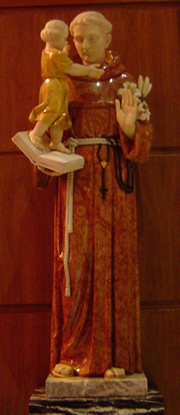About Our Shrines and Statues
Saint Anthony of Padua
« Back to About Our Shrines and Statues
 Saint Anthony of Padua, the saint of the whole universe, is still after more than 750 years, the world’s favorite.
Saint Anthony of Padua, the saint of the whole universe, is still after more than 750 years, the world’s favorite.
Go anywhere… everywhere, and there you will find the well known brown-robed figure with the familiar sandals, cowl and cord that betoken a son of St. Francis of Assisi. What a blessing he is to small boys and girls, mothers and fathers, the poor, the worker and all the people who will forever keep on losing those thousand-and-one things so necessary.
Contrary to common belief Saint Anthony was not always a member of the Franciscan Order, but was ordained a priest before he enrolled under the banner of the Little Poor Men of Assisi; his real name was not Anthony but Ferdinand, and he was not a native of Padua, but Lisbon.
Much credit must be given to his exemplary parents who from earliest childhood inculcated in him a great love of the Blessed Virgin.
Ferdinand, while still a young boy of 15 was violently tempted against purity; and after seeking protection from his heavenly Mother and realizing the power of the devil to lead him from the road of true happiness, he decided to seek a life of prayer, solitude and detachment within the cloister of the famous Monastery of Saint Vincent. The young novice, a model religious, soon afterwards requested to be sent away from his hometown to avoid the demands of too frequent visiting by his relatives.
The lily in his hand betokens his purity; the book his learning, and he Christ-Child his love for Jesus.
One day after his ordination, five Franciscans on their way to the Mohammedan Moors in Africa stayed overnight at the Holy Cross Monastery where he was stationed. All were martyred within the next six months.
The effect on zealous Father Ferdinand was immediate. He obtained the reluctant permission of his religious superiors and passed over to Franciscans where he took up residence in the little Convent of Saint Anthony of Coimbra. There he changed his name to Anthony probably in honor of the Abbot to whom the Church was dedicated.
When Father Anthony was sent on his quest of souls in Morrocco, the chances were all for martyrdom. It is easy to imagine the sacred fire of zeal that filled his whole being as he gazed for the first time on the land of Africa; we can share too in his anguish of soul, for before he could make one sermon or convert, he was struck down with a virulent fever that tortured him day and night for almost a year. What a dismal failure he was. Maybe he had been wrong in leaving the monastery where he had had all the means of serving God well. It was pains like these that made his sufferings almost unendurable.
Within twelve months after his jubilant arrival in Africa he was ordered home from the missions, deemed unfit for all forms of missionary activity. A victim of a shipwreck on his way home, he landed in Sicily and at the friars’ monastery in Messina began to recover his health.
It was quite by accident that Anthony finally found God’s job for him. He was called on to preach at an ordination ceremony because the appointed preacher failed to show up; and unprepared though he was, he filled the crowds with wonder, as he carried them to the heights of mystic theology. Although he was destined to preach only nine years in all, he gave himself untiringly to the work of his vocation. It wasn’t long after he settled in Padua that the flame of his noble spirit died out. Truly did the Blessed Virgin lead the young boy Ferdinand to the cloister only to later place him on the very pinnacle of sanctity as “THE WORLD’S FAVORITE”.
